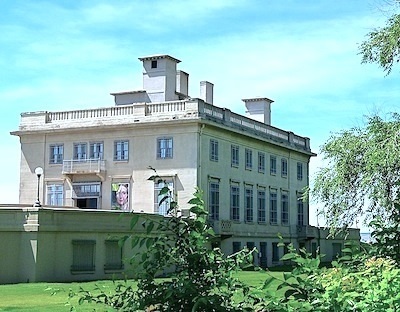Shore Excursion: Maryhill Museum of Art in Goldendale, Washington
Sam Hill wouldn’t have had to ask me twice to live here. Perched high on a bluff overlooking the Columbia River, the French-style mansion was designed to have eight suites and enough room for 250 dinner guests.
The opulent home was built by Hill for his wife. But she never lived here. Her loss. Our gain.
Today, the impressive structure is now the Maryhill Museum of Art. The “Mary” part of the name was in honor of Hill’s daughter, Mary.
“This was in the middle of nowhere when Sam Hill built this house for his wife,” says Ryan Downs, heritage leader for Un-Cruise Adventures. “She never lived here.”
In fact, this area was so undeveloped and off the beaten path that the name of “Sam Hill” supposedly became a catchphrase for someplace way out in the uncivilized boonies, Downs says. “Allegedly, Sam Hill’s wife coined that phrase because he dragged her out here to what she thought was nowhere.”
Who would think to find the world’s largest collection of sculptor Auguste Rodin’s work so far out in the country? And that is only the start of what this museum holds.
SAM HILL DISCOVERS THE PACIFIC NORTHWEST
Born May 13, 1857, in North Carolina, Sam Hill was a Quaker and a dedicated pacifist. He fell in love with the Pacific Northwest when he took a train ride through the Columbia River Gorge and saw nature’s treasures. Deciding he wanted to live here and create a Quaker farming community, Hill began building his dream home in 1914 and thought his wife and two children might be as delighted as he was to live in Goldendale, Washington.
When it became obvious that his wife wasn’t, Hill abandoned his mansion project in 1917. Rather than let the beautiful facility go to waste, Hill’s friend Loie Fuller encouraged Hill to turn it into an art museum. A pioneer of modern dance living in Paris, Fuller also was friends with well-known artists in France, which helped build the core of the museum’s collection.
In addition, Hill transferred his own art collections to the museum. That accounts for many of the artworks and culture on display of the indigenous peoples of North American. Intricate baskets, beadwork, and ancient petroglyphs are among the array of artifacts from Pacific Northwest and North American tribes.
Although it wasn’t totally completed, the museum was dedicated in 1926 by Hill’s friend, Queen Marie of Romania. The granddaughter of Britain’s Queen Victoria, Queen Marie was in exile at the time.
Hill didn’t live to see his museum be finished. He died Feb. 26, 1931. The museum was still filled with unpacked crates of art. And so it sat. Until 1937 when Hill’s friend, sugar heiress Alma de Brettevills Spreckels, decided to finish it in Hill’s honor. The museum was opened to the public on Hill’s birthday – May 13, 1940.
A $9.6 million expansion was added in May 2012 for a combined interior space of 35,000 square feet. Located 100 miles east of Portland, the castle-like chateau was placed on the National Register of Historic Places in 1974.
DIVERSE COLLECTION
One of the things I like most about the museum is its setting and the ability to see fantastic works of art up-close almost as in a private home. Of course, that is what the museum was meant to be.
Some of the collections I particularly enjoyed are:
~ 87 works by Auguste Rodin, considered the father of modern sculpture. The world-class collection of Rodin works includes bronzes, terracotta, plaster studies and watercolor sketches. It is amazing to see such well-known works as The Thinker, The Hand of God, The Age of Bronze and the life-size plaster of Eve from his masterwork, The Gates of Hell.
~ Queen Marie of Romania’s throne, crown jewels, gilt furniture, silverware, wedding dress and icon collection.
~ An unusual collection of about 100 chess sets. With great diversity, the sets represent the many counties, cultures and periods in which chess has been played.
~ One-third life-size mannequins wearing fashions of post-World War II France. The 1946 exhibit shows mannequins wearing fashions created by the country’s finest designers. To make it even better, nine different sets create elaborate backdrops for the mannequins as they showcase both casual and formal wear of the day.
~ A metal chest used by Hill to carry a beam fragment from the original pilgrim ship, Mayflower, from England to the United States. The relic was then placed in a vault within the Peace Arch at Blaine, Washington, in 1921. Two small planks removed from the fragment now rest inside this trunk.
~ The outdoor sculpture garden which was started in 1997. Scattered around museum ground are some interesting sculptures and neat places to rest and contemplate.
I spent the last half hour of my visit sitting on a bench in the garden watching the great Columbia River. I can certainly see why Sam Hill fell in love with the area. Strange that his wife didn’t. But then I never had to walk in her shoes. I am quite happy in my own.
Story and photo by Jackie Sheckler Finch















View Recent Comments